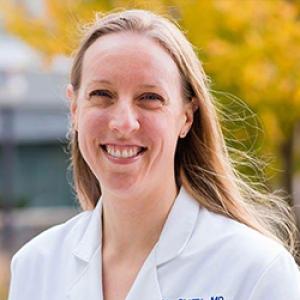
Anne D. Cherry, MD – 2016
2016 DIG Research Project | “Interface of Mitochondrial Dysfunction and Inflammation in Heterotopic Mouse Heart Transplant”
Background
Dr. Anne Cherry is a native Iowan who grew up on the south shore of Clear Lake, where she lived until she graduated high school. She moved slightly southeast to the University of Iowa for her undergraduate education where she was inspired by the faculty in the physics department. Dr. Cherry graduated with a B.S. in physics and a minor in chemistry and was honored to receive the James Van Allen award for an outstanding senior physics student. It was during her time at the University of Iowa that she realized a career in medicine, where she could combine the satisfaction of working with a variety of people and the pursuit of new scientific learning, would be most fulfilling for her.
The following year, she says she was fortunate enough to find herself at the Duke University School of Medicine. On a particularly lucky day during her second year, she stumbled into the hyperbaric laboratory while looking for research projects. She spent a year under the wing of Dr. Richard Moon, helping run a study of hemodynamics in exercising divers at simulated depth in the chamber. This is where she gained invaluable, firsthand experience in cardiorespiratory physiology and exposure to what was a new field for her, anesthesiology. She says the choice to pursue a residency was easy, as was the choice to stay in the Department of Anesthesiology at Duke. Dr. Cherry was offered a position in the Academic Careers Enrichment Scholars (ACES) program and spent a year doing research with Dr. Claude Piantadosi (Department of Medicine, Pulmonary Division) where she began to learn the most fundamental principles of mitochondrial function in disease states and how to assess the underlying mechanisms.
Her love of cardiopulmonary physiology was not short-lived. She spent a year as chief fellow in the cardiothoracic anesthesiology fellowship, completing her perioperative transesophageal echo certification. She was happy to join the faculty as an assistant professor at Duke University Medical Center where she currently works in the cardiac operating rooms and with a great group in the lab. She has continued her work with Dr. Piantadosi and most recently had the opportunity to expand their work with mitochondrial quality control in disease to address the contribution of mitochondrial function to cardiac dysfunction after heart transplant; problems that she and her colleagues see in their cardiac operating rooms on a daily basis.
Research
According to Dr. Cherry, primary graft dysfunction after cardiac transplant occurs in 7.5 percent of recipients; there is concern that the rate is increasing due to a) extension of ischemic time to facilitate organ distribution and b) an increased use of high risk donor organs as a result of increasing mismatch in organ demand vs. availability. She says graft dysfunction is a devastating complication, resulting in prolonged post-transplant hospitalization (often requiring invasive mechanical circulatory support or re-transplant, requiring still more resources) and a 35 percent, one-year mortality.
These studies will investigate mitochondrial susceptibility to primary graft dysfunction and consequent immune activation to facilitate new therapeutic strategies; specific investigations into the interaction of mitochondrial quality control and oxidative stress with inflammatory injury also apply to patients with graft dysfunction of other transplanted organs and to ischemia/reperfusion injury in other pathologic processes (i.e. myocardial infarction). Mechanistic insights will support new interventions to prevent organ graft dysfunction and I/R injury, as well as promote recovery.
Dr. Cherry says she is profoundly grateful to the donors who support the DREAM Innovation Grants for their sponsorship in developing a promising avenue of investigation. She is enthusiastic about continuing this work in collaboration with her colleagues in the Department of Surgery, with whom they have had a productive and stimulating relationship thus far. DIG funding will support the initial characterization of their model as it applies to heart transplant dysfunction, the application of novel tools (echocardiographic strain) for more sensitive quantification of dysfunction, and generation of preliminary data on the effects of mitochondrial regulatory defects on transplanted hearts. Data from these initial studies will help us to justify extramural support for further studies and, ultimately, to facilitate improved treatments for patients in our cardiac operating rooms and ICUs.